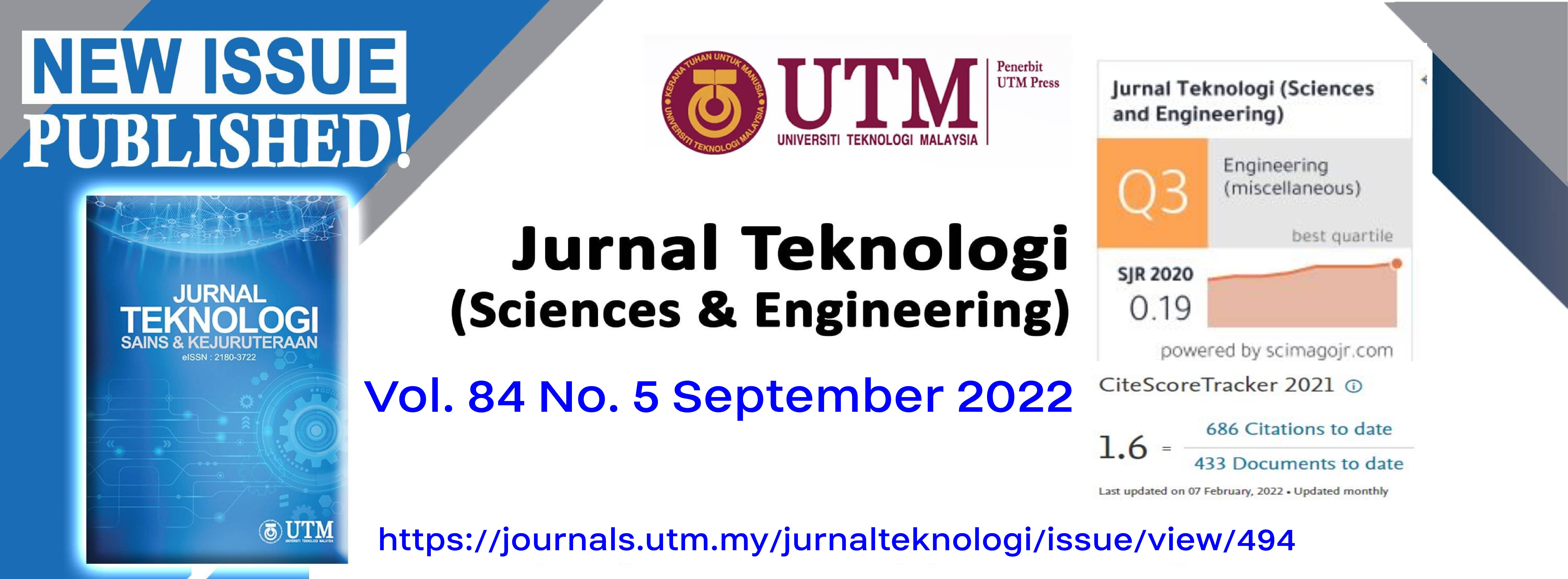DEVELOPMENT OF COST-EFFECTIVE ENERGY MANAGEMENT STRATEGY FOR STAND-ALONE HYBRID SYSTEM
DOI:
https://doi.org/10.11113/jurnalteknologi.v84.17704Keywords:
Renewable Energy, photovoltaic, wind turbine, microturbine, energy management system, state of chargeAbstract
Deployment of Photovoltaic (PV) and Wind Turbine (WT) as a stand-alone system are the most affordable solution to the electrification problem in the rural areas. However, the main challenge that hinder the sustainability of PV and WT is the output fluctuation. Thus, the battery and the non- Renewable Energy (RE) sources are required to make sure the continuous supply to the load is met. Therefore, the purpose of this paper is to propose the rule-based Energy Management Strategy (EMS) for the stand-alone hybrid system in order to ensure the continuity of supply and the minimum utilization of non-RE can be achieved. The continuous monitoring is designed to avoid the degradation of battery performance while minimizing the non-RE cost. The efficient Stage of Charge (SoC) limit of battery is investigated and applied in this study to store the excess RES power effectively. In this paper, the diesel fired Microturbine (MT) is selected as a non-RE source to integrate into the stand-alone hybrid system that consists of PV, WT and battery. The result shows that the proposed rule-based EMS for the in the stand-alone hybrid system is able to reduce the cost of MT operation to a minimum. Restricting the SoC limits effects the use of MT.
References
A. Kaabeche and R. Ibtiouen. 2014. Techno-economic Optimization of Hybrid Photovoltaic/wind/diesel/battery Generation in a Stand-alone Power System. Sol. Energy. 103: 171-182.
Doi: 10.1016/j.solener.2014.02.017.
M. S. Javed, A. Song, and T. Ma. 2019. Techno-economic Assessment of a Stand-alone Hybrid Solar-wind-battery System for a Remote Island using Genetic Algorithm. Energy. 176: 704-717.
Doi: 10.1016/j.energy.2019.03.131.
X. Li, Q. Zhou, Y. Qiu, and Y. Hou. 2019. Capacity Configuration Method of Hybrid Energy Storage System for Stand-Alone Photovoltaic Generation System. Proc. 2019 IEEE 3rd Adv. Inf. Manag. Commun. Electron. Autom. Control Conf. IMCEC 2019. 1704-1709.
Doi: 10.1109/IMCEC46724.2019.8984110.
M. H. Nehrir et al. 2000. An Approach to Evaluate the General Performance of Stand-Alone Wind / Photovoltaic Generating Systems. IEEE Transactions on Energy Conversion. 15(4): 433-439.
Doi: 10.1109/60.900505.
K. Sehil and M. Darwish. 2018. Effective Power Management in a Stand-alone PV System. Proc. - 2018 53rd Int. Univ. Power Eng. Conf. UPEC 2018. 6-10.
Doi: 10.1109/UPEC.2018.8541924.
M. Jafar, H. Moghaddam, A. Kalam, and S. Arabi. 2019. Optimal Sizing and Energy Management of Stand-alone Hybrid Photovoltaic/wind System based on Hydrogen Storage Considering LOEE and LOLE Reliability Indices using Fl Ower Pollination Algorithm. Renew. Energy. 135: 1412-1434.
Doi: 10.1016/j.renene.2018.09.078.
T. Alnejaili, D. Mehdi, A. Alibi, and S. Drid. 201. An Advanced Energy Management System with an Economical Optimization for a Multi-sources Stand-alone Home. International Conference on Systems and Control (ICSC). 154-159.
Doi: 10.1109/ICoSC.2018.8587815.
M. Wu. 2019. Multi-time Scale Energy-Management Strategy Based on Rule Reasoning for Stand-alone Microgrid. 19-23.
D. López, I. Yahyaoui, F. Tadeo, and S. Arnaltes. 2019. On the Energy Management for a Stand-alone Hybrid System in Isolated Area. 10th International Renewable Energy Congress (IREC). 0-4.
Doi: 10.1109/IREC.2019.8754638.
M. Laraki and C. Z. El-bayeh. 2021. Energy Management System for a Stand-alone Wind / Diesel / BESS / Fuel-cell Using Dynamic Programming. 18th International Multi-Conference on Systems, Signals & Devices (SSD). 1258-1263.
Doi: 10.1109/SSD52085.2021.9429362.
G. Bhavani and R. Kishore. 2020. Battery Protection Scheme Integrated with Demand Side Management in Stand Alone Hybrid Microgrid. International Symposium on Sustainable Energy, Signal Processing and Cyber Security (iSSSC).
Doi:10.1109/iSSSC50941.2020.9358847.
Wang and M. H. Nehrir. 2007. A Physically Based Dynamic Model for Solid Oxide Fuel Cells. IEEE Transactions on Energy Conversion. 22(4): 887-897.
Doi:10.1109/TEC.2007.895468.
J. P. Rivera-Barrera, N. Muñoz-Galeano, and H. O. Sarmiento-Maldonado. 2017. Soc Estimation for Lithium-ion Batteries: Review and Future Challenges. Electronics. 6(4).
Doi: 10.3390/electronics6040102.
L. Mahendra, V. Lystianingrum, and A. Priyadi. 2020. Energy Management Design for Industrial Demand Considering PV Power Prediction and Battery SOC. Proc. - 2020 Int. Semin. Intell. Technol. Its Appl. Humanification Reliab. Intell. Syst. ISITIA 2020. 357-362.
Doi: 10.1109/ISITIA49792.2020.9163787.
R. Zhang et al. 2018. A Study on the Open Circuit Voltage and State of Charge Characterization of High Capacity Lithium-Ion Battery Under Different Temperature. Energies. 11(9).
Doi: 10.3390/en11092408.
R. Belfkira, O. Hajji, C. Nichita, and G. Barakat. 2007. Optimal Sizing of Stand-alone Hybrid Wind/PV System with Battery Storage. 2007 Eur. Conf. Power Electron. Appl. EPE.
Doi: 10.1109/EPE.2007.4417586.
R. Al Badwawi, M. Abusara, and T. Mallick. 2015. A Review of Hybrid Solar PV and Wind Energy System. Smart Sci. 3(3): 127-138.
Doi: 10.1080/23080477.2015.11665647.
S. A. Pourmousavi, M. H. Nehrir, C. M. Colson, and C. Wang. 2010. Real-time Energy Management of a Stand-alone Hybrid Wind-microturbine Energy System using Particle Swarm Optimization. IEEE Trans. Sustain. Energy.
Doi: 10.1109/TSTE.2010.2061881.
J. Jiang et al. 2014. Optimized Operating Range for Large-Format LiFePO 4 /Graphite Batteries. J. Electrochem. Soc. 161(3): A336-A341.
Doi: 10.1149/2.052403jes.
S. Singh. 2012. Competitiveness of a Natural Gas Microturbine. Electrical & Computer Engineering (CCECE), 2012 25th IEEE Canadian Conference on January 2019.
Doi: 10.1109/CCECE.2012.6334969.
M. Y. H. Othman, K. Sopian, B. Yatim, and M. N. Dalimin. 1993. Diurnal Pattern of Global Solar Radiation in the Tropics: A Case Study in Malaysia. Renew. Energy. 3(6-7): 741-745.
Doi: 10.1016/0960-1481(93)90081-Q.
C. Wang and M. H. Nehrir. 2008. Power Management of a Stand-alone Wind/photovoltaic/fuel Cell Energy System. IEEE Trans. Energy Convers. 23(3): 957-967.
Doi: 10.1109/TEC.2007.914200.
C. Wang, C. M. Colson, M. H. Nehrir, and J. Li. 2009. Power Management of a Stand-alone Hybrid Wind-microturbine Distributed Generation System. Power Electronics and Machines in Wind Applications, 2009. PEMWA 2009. IEEE.
Doi: 10.1109/PEMWA.2009.5208375.
Downloads
Published
Issue
Section
License
Copyright of articles that appear in Jurnal Teknologi belongs exclusively to Penerbit Universiti Teknologi Malaysia (Penerbit UTM Press). This copyright covers the rights to reproduce the article, including reprints, electronic reproductions, or any other reproductions of similar nature.
















